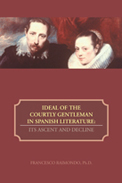"Montalvo, by skillfully blending outside literary currents with patterns of traditional Spanish thought on courtship and marriage, was able to present and modify the theme of "courtly love" in a manner that met the approval of the church and the Spanish reader."

 |
Ideal of the Courtly Gentleman in Spanish Literature:
Its Ascent and Decline by Francesco Raimondo, Ph.D. Trafford Publishing
book review by Caroline Blaha-Black
Dr. Raimondo's engaging, scholarly work compares several literary texts that deal with the ideals of the courtly gentleman who flourished in Europe in the 16th century.
The first part of the book is concerned with comparing the Il Cortegiano by Baldassare Castiglione, a rule book and etiquette manual for the ideal society and gentleman of the era with an earlier work of romantic chivalry by Garci Rodriguez de Montalvo's Amadis de Gaula. The author highlights the similarities between both works and what defines a perfect gentleman. Both Cortegiano and Amadis share the necessary qualities of noble birth, military prowess, and their love and devotion to their lady, for example, but Dr. Raimondo also points out the key differences in both works. In Cortegiano, the emphasis is more on physical aesthetic and education, while in Amadis the hero must mainly show prowess in war. Both works also have a different view of honor and how it's interpreted.
The second part of the book deals with the analysis of courtliness as described in Don Quijote by Miguel de Cervantes Saavedra, dramas of Pedro Calderon de la Barca, and others. The author's tone is scholarly and clear, and he gets his point across with multiple quotes from the original texts, footnotes, and translations. At the end of the book, an extensive list of cited works and primary sources can be found. Also of note are the quotes in the book, in Spanish and Italian, in which the works were originally written. This lends the book an authentic air.
This not-often explored treatise is perfect for someone who loves classic literature, a bilingual person with knowledge of both Spanish and Italian, and for students of literary texts.
RECOMMENDED by the US Review